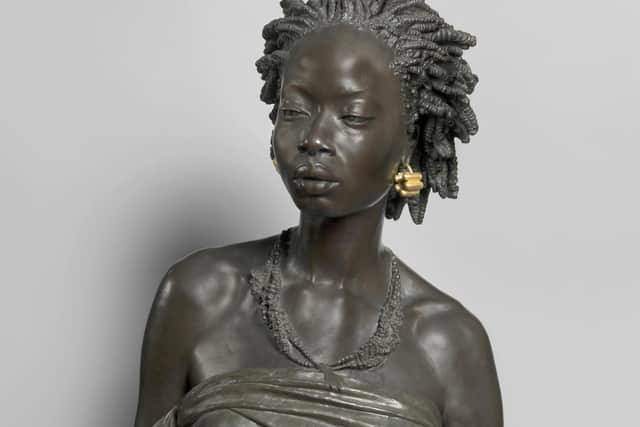Thought-provoking exhibition at the Henry Moore Institute takes a new look at Victorian sculpture
The Colour of Anxiety: Race, Sexuality and Disorder in Victorian Sculpture focusses on sculpture exhibited and collected in Britain between 1850 and 1900, a rich yet largely overlooked body of work. Co-curated by Dr Nicola Jennings, director of Athena Arts Foundation and former associate lecturer at the Courtauld Institute of Art, and Dr Adrienne L Childs, independent scholar and adjunct curator at the Phillips Collection, Washington DC, the show examines objects that introduced colour and new materials into the sculptural process within the context of the anxiety-inducing scale of change that was taking place in Victorian society in terms of social, political, technological and scientific advances.
“I think Victorian sculpture has fallen out of fashion a bit – and is mostly referred to now in the context of monuments being pulled down, so I thought it would be an interesting time to look at some of those objects again,” says Jennings. “I had been talking to Adrienne about some of these issues and we suggested to the Henry Moore Institute that we might revisit those artworks in an exhibition in terms of race, sexuality and anxiety about change.”
Advertisement
Hide AdAdvertisement
Hide AdChilds, whose academic interests focus on the relationship between race and representation in European and American fine and decorative arts, says that approaching the artworks in this way led them down a range of avenues of exploration. “Looking at these objects through this lens unpicks the issues in a new way and opens up a lot of other roads. That was one of our challenges – how do we bring all these objects and those ideas together into one space.” The result is an intelligent, multi-layered and thought-provoking exhibition, that prompts the viewer to ask questions about the representation of women, especially women of colour, in work created by male artists. The sculptures reflect certain attitudes which prevailed at the time – revealing the nervousness, or anxiety, with which women were viewed by men – and how those male artists responded to and reinforced a concept of the female body, influenced by those anxieties.


“There were many societal changes taking place in relation to women and the status of women,” says Jennings. “They still weren’t allowed to vote but there were changes in women’s property rights. Many men felt threatened by the education of women and the prospect of female emancipation – and in fact the psychiatrist Henry Maudsley was writing and talking about the ‘dangers’ of educating women. The really seismic change in Victorian society was Darwin and his theory of evolution – it shook people up enormously – and also the abolition of slavery and what that meant for Britain and America.”
“The notion of anxiety has broken into much of what we are talking about,” adds Childs. “Since many of the works we ended up choosing are images of women in chains and enslaved women created post-abolition – it is interesting that those works became very popular and important after slavery has been abolished. Looking at them you can see also embedded there an anxiety about women, and their sexuality, in general. Those sculptures were supposed to suggest sympathy for the enslaved but there is an implied sexualisation.”
Both curators hope that visitors to the exhibition will be inspired by it in terms of the quality of the artworks on display but also by the questions and debates those objects might raise. “I would like people to marvel at the works in terms of the craftsmanship and materials but at the same time ask why they were produced,” says Jennings. “And to think about what they tell us about the society in which they were produced and how that relates to how we think about ourselves today.” Childs agrees. “This is not a definitive survey – it is an essay and we want people to join the conversation,” she says. “I would like people to think about the ideas that were circulating at that time about race and sexuality. It was perfectly acceptable in Victorian society to commission a sculpture of naked slave woman to put on your mantle. If you think about that, it gives you some indication of what people are still fighting against today. I want people to think about the history of that and maybe look into it a bit more.”
At the Henry Moore Institute, Leeds until February 22. Free entry.